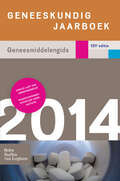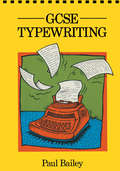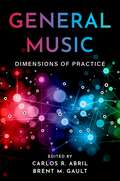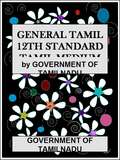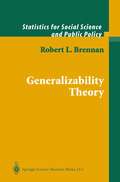- Table View
- List View
Genderspezifische Herausforderungen der Sozialwirtschaft: Eine Einführung (Basiswissen Sozialwirtschaft und Sozialmanagement)
by Petra MerenheimoGeschlecht wird in den wissenschaftlichen Studien häufig als eine unabhängige Kategorie behandelt. Dadurch kann z.B. die Geschlechterverteilung in den Leitungspositionen der sozialen Organisationen sichtbar gemacht werden. Es existiert aber eine Vielfalt von geschlechterspezifischen Perspektiven und Methoden, die eine kritische Analyse der Sozialwirtschaft ermöglichen. In diesem Buch werden die allgemein anerkannten entscheidungstheoretischen Grundannahmen wie die der Rationalität und Reflexivität aus der Geschlechterperspektiven betrachtet und aktuelle Konzepte wie das der Nachhaltigkeit um die Geschlechterperspektive erweitert.
A Genealogy of Equality: The Curriculum for Social Work Education and Training (Woburn Education Series)
by Dr Hilary Walker Hilary WalkerThis account of the incorporation of issues of equality into the social work education curriculum focuses upon the period between 1989 and 1995, a time of considerable activity and rapid change. It is based upon research carried out by the author whilst studying for a doctorate in education.
A Genealogy of Equality: The Curriculum for Social Work Education and Training (Woburn Education Series)
by Dr Hilary Walker Hilary WalkerThis account of the incorporation of issues of equality into the social work education curriculum focuses upon the period between 1989 and 1995, a time of considerable activity and rapid change. It is based upon research carried out by the author whilst studying for a doctorate in education.
Geneeskundig jaarboek 2014: Geneesmiddelengids 131e editie
Het Geneeskundig Jaarboek 2014 is hét recept voor iedereen die medicijnen voorschrijft, verkoopt of toedient. In het jaarboek vind je de beschrijving van alle werkzame geregistreerde geneesmiddelen in Nederland, dat zijn er meer dan 2.000.In deze 131e jaargang van het Geneeskundig Jaarboek is een aantal verbeteringen aangebracht. Zoals elk jaar is de Lijst van geneesmiddelen bijgewerkt, wat heeft geleid tot een uitbreiding met veertig nieuwe geneesmiddelen of nieuwe geneesmiddelencombinaties die in het afgelopen jaar bij de Nederlandse of de Europese registratieautoriteit zijn geregistreerd.In het Geneeskundig Jaarboek is een nieuw waarschuwingsicoontje opgenomen in de Lijst van geneesmiddelen, namelijk betreffende lactatie. Hiermee wordt de informatiewaarde verder verhoogd.
General and Special Education Inclusion in an Age of Change: Roles of Professionals Involved (Advances in Special Education #32)
by Jeffrey P. Bakken Festus E. ObiakorThis volume addresses general and special education inclusion and how the education field has changed over time. The topic of inclusion has transformed over the years from when it was first introduced and as a result of legislation, new trends, and current research investigations. In addition, this topic can be somewhat controversial depending on the disability the child might have or those professionals involved in the process of instructing individuals with disabilities. Currently, there is no comprehensive resource that effectively covers these advances with the breath of topics as this volume. This volume will address the most current perspectives and issues related to general and special education inclusion and will be written by leaders in the field with particular expertise in this area. This volume will be an excellent resource for special educators, administrators, mental health clinicians, school counsellors, and psychologists. The layout of the volume will allow readers to follow general and special education inclusion in a very logical and thoughtful process from students with high incidence disabilities to those with low incidence disabilities.
General and Special Education Inclusion in an Age of Change: Impact on Students with Disabilities (Advances in Special Education #31)
by Jeffrey P. Bakken Festus E. ObiakorThis volume addresses general and special education inclusion and how the education field has changed over time. The topic of inclusion has transformed over the years from when it was first introduced and as a result of legislation, new trends, and current research investigations. In addition, this topic can be somewhat controversial depending on the disability the child might have or those professionals involved in the process of instructing individuals with disabilities. Currently, there is no comprehensive resource that effectively covers these advances with the breath of topics as this volume. This volume will address the most current perspectives and issues related to general and special education inclusion and will be written by leaders in the field with particular expertise in this area. This volume will be an excellent resource for special educators, administrators, mental health clinicians, school counsellors, and psychologists. The layout of the volume will allow readers to follow general and special education inclusion in a very logical and thoughtful process from students with high incidence disabilities to those with low incidence disabilities.
General Certificate of Secondary Education Typewriting
by Paul BaileyThis book, written by the author of several typing books, is designed for GCSE and is a replacement for "Comprehensive Typing". It includes information on keyboarding, speed and accuracy, paragraphs, correction signs, letters, typing envelopes, abbreviations, displays, tabulations and footnotes.
General Eating and Drinking Advice (CFVI Resource)
by Guide DogsGuidance focusing on 'General Eating and Drinking Advice'. CFVI Area 6. Habilitation: Independent Living Skills Resource Type: Instruction Guide for independent living skills
General Education Essentials: A Guide for College Faculty
by Paul HanstedtGeneral Education Essentials "Full-time and part-time faculty in any discipline and at any size campus with any type of mission can pick up this volume and learn something that will help her or him improve teaching and learning.???"—From the Foreword by Terrel L. Rhodes, vice president for Curriculum, Quality, and Assessment, Association of American Colleges and Universities Every year, hundreds of small colleges, state schools, and large, research-oriented universities across the United States (and, increasingly, Europe and Asia) revisit their core and general education curricula, often moving toward more integrative models. And every year, faculty members who are highly skilled in narrowly defined fields ask two simple questions: "Why?" and "How is this going to affect me?" General Education Essentials seeks to answer these and other questions by providing a much-needed overview of and a rationale for the recent shift in general education curricular design, a sense of how this shift can affect a faculty member's teaching, and an understanding of how all of this might impact course and student assessment. Filled with examples from a variety of disciplines that will spark insights, General Education Essentials explores the techniques that can be used to ensure that students are gaining the skills they need to be perceptive scholars and productive citizens. "This is THE ONE BOOK for academics to get up to speed about reforming general education." —Jerry Gaff, senior scholar, Association of American Colleges and Universities
General Education Essentials: A Guide for College Faculty
by Paul HanstedtGeneral Education Essentials "Full-time and part-time faculty in any discipline and at any size campus with any type of mission can pick up this volume and learn something that will help her or him improve teaching and learning.???"—From the Foreword by Terrel L. Rhodes, vice president for Curriculum, Quality, and Assessment, Association of American Colleges and Universities Every year, hundreds of small colleges, state schools, and large, research-oriented universities across the United States (and, increasingly, Europe and Asia) revisit their core and general education curricula, often moving toward more integrative models. And every year, faculty members who are highly skilled in narrowly defined fields ask two simple questions: "Why?" and "How is this going to affect me?" General Education Essentials seeks to answer these and other questions by providing a much-needed overview of and a rationale for the recent shift in general education curricular design, a sense of how this shift can affect a faculty member's teaching, and an understanding of how all of this might impact course and student assessment. Filled with examples from a variety of disciplines that will spark insights, General Education Essentials explores the techniques that can be used to ensure that students are gaining the skills they need to be perceptive scholars and productive citizens. "This is THE ONE BOOK for academics to get up to speed about reforming general education." —Jerry Gaff, senior scholar, Association of American Colleges and Universities
General Education Essentials: A Guide for College Faculty
by Paul HanstedtSupplying an insightful introduction to current trends in general education reform, this second edition of General Education Essentials: A Guide for College Faculty gives an important, timely overview of general education curricular design. General education curricula provide students with the intellectual flexibility they need to adapt thoughtfully and productively to the rapid changes of the workplace and the world at large. This book offers methods for engaging in curricular reform efforts that support university culture and teachers and examines the implications of general education reform in the classroom, with a keen eye toward syllabi, course content, and student work. By expertly blending theory with curricular ideas for implementation, this text offers an impactful illustration of the shift from distributive to integrative to high impact models of general education. Featuring plentiful examples from a variety of fields and disciplines, this book is essential reading for any higher education faculty member tasked with equipping students with the skills they need to become perceptive scholars and productive citizens.
General Education Essentials: A Guide for College Faculty
by Paul HanstedtSupplying an insightful introduction to current trends in general education reform, this second edition of General Education Essentials: A Guide for College Faculty gives an important, timely overview of general education curricular design. General education curricula provide students with the intellectual flexibility they need to adapt thoughtfully and productively to the rapid changes of the workplace and the world at large. This book offers methods for engaging in curricular reform efforts that support university culture and teachers and examines the implications of general education reform in the classroom, with a keen eye toward syllabi, course content, and student work. By expertly blending theory with curricular ideas for implementation, this text offers an impactful illustration of the shift from distributive to integrative to high impact models of general education. Featuring plentiful examples from a variety of fields and disciplines, this book is essential reading for any higher education faculty member tasked with equipping students with the skills they need to become perceptive scholars and productive citizens.
General English class 12 - Tamil Nadu Board
by Accessable E-Book Production Unit KVFThe General English syllabus for Class 12 aligns with the Recommendations of the National curriculum framework to understand and appreciate prose, poetry and drama inculcate creativity and initiative.
General Equilibrium Foundation of Partial Equilibrium Analysis
by Takashi HayashiThis book addresses the gaps in undergraduate teaching of partial equilibrium analysis, providing a general equilibrium viewpoint to illustrate the assumptions underlying partial equilibrium welfare analysis. It remains unexplained, at least at the level of general economics teaching, in what sense partial equilibrium analysis is indeed a part of general equilibrium analysis. Partial equilibrium welfare analysis isolates a market for a single commodity from the rest of the economy, presuming that other things remain equal, and measures gains and losses by means of consumer surplus. This is a money metric that is supposed to be summable across individuals, recommending policy that maximizes the social surplus. But what justifies such apparently uni-dimensional practise? Within a general equilibrium framework, the assumption of no income effect is presented as the key condition, and substantive general equilibrium situations in which the condition emerges are presented. The analysis is extended to the case of uncertainty, in which the practice adopts aggregate expected consumer surplus, and scrutinizes when such practice is justified. Finally, the book illustrates partial equilibrium as an institutional artifact, meaning that institutional constraint induces individuals to behave as if they are in partial equilibrium. This volume forms an important contribution to the literature by researching why this disparity persists and the implications for economics education.
General Equilibrium Foundation of Partial Equilibrium Analysis
by Takashi HayashiThis book addresses the gaps in undergraduate teaching of partial equilibrium analysis, providing a general equilibrium viewpoint to illustrate the assumptions underlying partial equilibrium welfare analysis. It remains unexplained, at least at the level of general economics teaching, in what sense partial equilibrium analysis is indeed a part of general equilibrium analysis. Partial equilibrium welfare analysis isolates a market for a single commodity from the rest of the economy, presuming that other things remain equal, and measures gains and losses by means of consumer surplus. This is a money metric that is supposed to be summable across individuals, recommending policy that maximizes the social surplus. But what justifies such apparently uni-dimensional practise? Within a general equilibrium framework, the assumption of no income effect is presented as the key condition, and substantive general equilibrium situations in which the condition emerges are presented. The analysis is extended to the case of uncertainty, in which the practice adopts aggregate expected consumer surplus, and scrutinizes when such practice is justified. Finally, the book illustrates partial equilibrium as an institutional artifact, meaning that institutional constraint induces individuals to behave as if they are in partial equilibrium. This volume forms an important contribution to the literature by researching why this disparity persists and the implications for economics education.
General Music: Dimensions of Practice
by Carlos R. Abril and Brent M. GaultGeneral Music: Dimensions of Practice is a practical guide for music teachers and teaching artists who strive to teach music holistically. The book begins by framing general music as a holistic music education that is comprehensive, meaningful, and relevant to diverse learners in school and community settings. It is followed by chapters that are organized into one of four dimensions of music practice: performing, connecting, creating, and responding. Chapter authors share creative and innovative teaching ideas, for both elementary and secondary school students, that focus on a wide range of topics, including: songwriting, composing, improvising, singing, moving, playing, listening, analyzing, contextualizing, and connecting. Each chapter provides (a) a rationale for a given area of music study, establishing its importance and relevance; (b) a research or theoretical background, to inform and guide practice; and (c) a pedagogical model or framework illustrated through lesson ideas, curriculum units, or vignettes. The ideas in this book seek to inspire and guide teachers as they build comprehensive music programs that are informed by students and communities.
General Music: Dimensions of Practice
General Music: Dimensions of Practice is a practical guide for music teachers and teaching artists who strive to teach music holistically. The book begins by framing general music as a holistic music education that is comprehensive, meaningful, and relevant to diverse learners in school and community settings. It is followed by chapters that are organized into one of four dimensions of music practice: performing, connecting, creating, and responding. Chapter authors share creative and innovative teaching ideas, for both elementary and secondary school students, that focus on a wide range of topics, including: songwriting, composing, improvising, singing, moving, playing, listening, analyzing, contextualizing, and connecting. Each chapter provides (a) a rationale for a given area of music study, establishing its importance and relevance; (b) a research or theoretical background, to inform and guide practice; and (c) a pedagogical model or framework illustrated through lesson ideas, curriculum units, or vignettes. The ideas in this book seek to inspire and guide teachers as they build comprehensive music programs that are informed by students and communities.
General Practice Cases at a Glance (At a Glance)
by Carol Cooper Martin BlockGeneral Practice Cases at a Glance is a workbook of clinical scenarios, ideal for those working in general practice, on their GP rotations, or looking to improve their history-taking, diagnostic and management planning skills. Written by practising teaching GPs, it provides an accessible overview of the richness and complexity of general practice. With 50 engaging consultations, covering all age ranges and a broad spread of clinical areas, each symptom-based chapter begins with the clinical presentation of a patient, before going on to uncover the full history and examination. As you work through each true-to-life case, there are red flag symptoms, useful charts and tables, and further resources to deepen your knowledge. General Practice Cases at a Glance: Is suitable for clinical students, Foundation doctors, and those preparing for the MRCGP's CSA Includes 50 case scenarios from across the medical spectrum, from mental health and paediatrics to musculoskeletal and ENT medicine Is comprehensively illustrated Features current clinical guidelines, and charts and tables to accompany each case Is the companion volume to General Practice at a Glance, ISBN 978-0-470-65551-1, (Awarded First Prize in the Primary health care category at the 2013 BMA Medical Book Awards) but is also a stand-alone resource
General Practice Cases at a Glance (At a Glance)
by Carol Cooper Martin BlockGeneral Practice Cases at a Glance is a workbook of clinical scenarios, ideal for those working in general practice, on their GP rotations, or looking to improve their history-taking, diagnostic and management planning skills. Written by practising teaching GPs, it provides an accessible overview of the richness and complexity of general practice. With 50 engaging consultations, covering all age ranges and a broad spread of clinical areas, each symptom-based chapter begins with the clinical presentation of a patient, before going on to uncover the full history and examination. As you work through each true-to-life case, there are red flag symptoms, useful charts and tables, and further resources to deepen your knowledge. General Practice Cases at a Glance: Is suitable for clinical students, Foundation doctors, and those preparing for the MRCGP's CSA Includes 50 case scenarios from across the medical spectrum, from mental health and paediatrics to musculoskeletal and ENT medicine Is comprehensively illustrated Features current clinical guidelines, and charts and tables to accompany each case Is the companion volume to General Practice at a Glance, ISBN 978-0-470-65551-1, (Awarded First Prize in the Primary health care category at the 2013 BMA Medical Book Awards) but is also a stand-alone resource
General Studies Indian Economy I and II - competitive exam
by Sriram IasThe best book on Indian Economy By SRIRAM IAS, recommended by civil service exam experts. The book includes the previous year question and point by point description and analysis.
General Tamil class 11 - Tamil Nadu Board - SCERT: பொது தமிழ் வகுப்பு 11 - தமிழ்நாடு வாரியம் - எஸ்.சி.இ.ஆர்.டி.
by Government TamilnaduEducation is not only the way to become wise but it is the foundation of life forever. We have understood that the textbooks in students hands create a way to succeed as well as lead others to follow up with new inventions. The methods and technics used in this book will definitely make the students to feel free and comfortable even while learning tough concepts.
General Tamil class 12 - Tamil Nadu Board
by Government TamilnaduEducation is not only the way to become wise but it is the foundation of life forever. We have understood that the textbooks in students hands create a way to succeed as well as lead others to follow up with new inventions. The methods and technics used in this book will definitely make the students to feel free and comfortable even while learning tough concepts.
General Teaching Council
by John SayerBeginning in 2000, all teachers must register with the GTC annually and pay an annual fee. John Sayer has been strongly involved in negotiations on the GTC since 1980. Here he offers an insider's view, including personal correspondence with the key players.
Generalizability Theory (Statistics for Social and Behavioral Sciences)
by Robert L. BrennanGeneralizability theory offers an extensive conceptual framework and a powerful set of statistical procedures for characterizing and quantifying the fallibility of measurements. Robert Brennan, the author, has written the most comprehensive and up-to-date treatment of generalizability theory. The book provides a synthesis of those parts of the statistical literature that are directly applicable to generalizability theory. The principal intended audience is measurement practitioners and graduate students in the behavioral and social sciences, although a few examples and references are provided from other fields. Readers will benefit from some familiarity with classical test theory and analysis of variance, but the treatment of most topics does not presume specific background.
Generalized Musical Intervals and Transformations
by David LewinDavid Lewin's Generalized Musical Intervals and Transformations is recognized as the seminal work paving the way for current studies in mathematical and systematic approaches to music analysis. Lewin, one of the 20th century's most prominent figures in music theory, pushes the boundaries of the study of pitch-structure beyond its conception as a static system for classifying and inter-relating chords and sets. Known by most music theorists as "GMIT", the book is by far the most significant contribution to the field of systematic music theory in the last half-century, generating the framework for the "transformational theory" movement. Appearing almost twenty years after GMIT's initial publication, this Oxford University Press edition features a previously unpublished preface by David Lewin, as well as a foreword by Edward Gollin contextualizing the work's significance for the current field of music theory.


